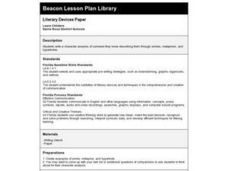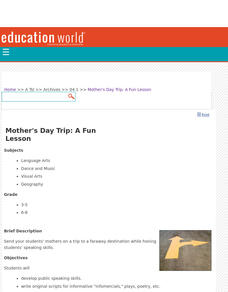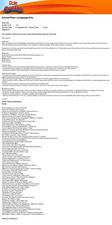Curated OER
Eating Up Idioms
Ah, food idioms! Now that sounds tasty. Class members read and discuss various food-related idioms, create an illustration of a food-related idiom, and develop a class book or bulletin board to celebrate figurative language and National...
Curated OER
Food and Languages of the World
Students listen to the story "No Blue Food" in this lesson. They then discuss Allegra, the main character, and her hesitation to try new foods. They participate in a matching game in which they match cards to determine a fruit topping...
Curated OER
Poetry Gifts
What kind of shoe is this person? What time of day is this person? Aspiring poets’ responses to a list of questions provide descriptive words and phrases that can be crafted into a blank verse poem. A link to sample poems is provided.
Curated OER
F.B.I.
Students create a worm bin full of fruit and vegetable scraps wit paper and observe what happens over time. In this decomposers lesson plan, students observe that the fruit and vegetable scraps become new soil.
Curated OER
Literary Devices Paper
Fourth graders write a character analysis of someone they know describing them through similes, metaphors, and hyperboles. They may include themselves and how their person relates to him or her.
Curated OER
Mother's Day Trip
Help your class develop their public speaking skills. They write original scripts for informative infomercials, plays, or poetry. They work to present their information with purpose.
Curated OER
Chuukese Dinner (high School)
Students read journal entries about having dinner with a Chuukese family. Using this information, they identify which foods sound appealing and compare and contrast Micronesian and American foods, fruits and vegetables. In groups, they...
Curated OER
Riddle Poem
Second graders practice writing skills by writing riddle poems using adjectives to describe vegetables.
Curated OER
Adjective Riddles
Students create a riddle using adjectives to describe an unknown edible substance to their classmates.
Curated OER
Buzzing Bee's Wardrobe
Students investigate the anatomy of honeybees. In this anatomy instructional activity, students research the physical characteristics of bees and discover what they do. Students create a model of a honeybee showing the correct anatomy.
Curated OER
The Giving Tree Gives
Students study both poetry and science in this language arts activity for early elementary, Special Education, and LEP students. They listen to Shel Silverstein's, The Giving Tree, and discuss its contents. They graph apple types, make...
Curated OER
The Touch N Feel Box
Learners discover the characteristics of living and non living objects without the use of sight. In this sense of touch lesson, students touch items put in a shoe box and must identify whether the item was once living or not by...
Curated OER
Book Box
Students create a bookmark, book cover and book review for a book they read. In this nutrition meets literacy lesson, students read a book about food and complete creative projects based upon the book. Some of the ideas included in this...
Curated OER
Three Healthful Meals: A Practical Food-Guide-Pyramid Activity
Students activate their knowledge of the food guide pyramid and the basic food groups in order to plan nutritious meals. They collect a handful of food images from magazines and glue them to the appropriate plates.
Curated OER
Too Bee Or Not To Bee
Students recognize that bees are important in the reproduction of plants and to the survival of animals. In this bee lesson, students become familiar with the parts of bees and how those adaptations help them pollinate plants....
Curated OER
The Story of Kwanzaa
Celebrate Kwanzaa with a game of Kalah, also known as Mankala or Owara. Using an egg carton and a set of beans, players take all of the beans out of one of his or her cups and move to the right, dropping one bean into each of the...















